Site pages
Current course
Participants
General
Module 1. Basic Concepts, Conductive Heat Transfer...
Module 2. Convection
Module 3. Radiation
Module 4. Heat Exchangers
Module 5. Mass Transfer
Lesson 4. One dimensional steady state conduction through plane and composite walls, tubes and spheres with heat generation
One-Dimensional, Steady State Heat Conduction with Heat Generation:
One dimensional, steady state heat conduction is considered for following geometries
1) Slab
2) Cylinder
3) Sphere
1) One-Dimensional Heat Flow through a slab with Heat Generation:
i) When Temperature of Both Sides of Slab is Same:
Consider a slab of thickness ‘L’ and cross-sectional area ‘A’ through which heat flow takes place in x-direction. A heat source located at the center of the slab is generating ‘qg’ amount of heat per unit volume per unit time as shown in Figure 1.
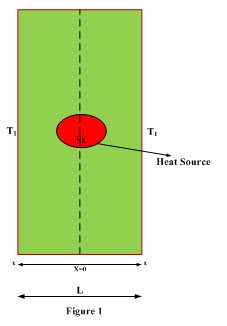
Heat generated is conducted equally towards the sides of the slab through a distance ‘x’ measured from center of the slab along x-direction. Temperature of both sides of the slab is same and is equal to T1 as same amount of heat is flowing from the center towards the sides of the slab.
At the center of the slab x=0 and at the sides of the slab x= L/2. The general conduction equation under the given conditions reduces to

Integrating equation (1) with respect to ‘x’, we get

Integrating equation (2) again with respect to ‘x’, we get

Using the boundary conditions,
At x = 0, , From equation (2), we get

At x = L/2, T = T1, From equation (3), we get

Substituting the values of and in equation (3), we get

Equation (6) represents temperature distribution equation in the slab having a heat generating source present inside it.
Temperature will be maximum at the center of the slab where x = 0

Flow of heat can be expressed as:

Using equation (2), we can write

Substituting value of  from equation (9) in equation (8), we get
from equation (9) in equation (8), we get

Equation (10) represents flow from one of sides of the slab; therefore, total heat flow from both the sides is expressed as
![]()
Total Heat Conducted form both sides of the slab = Volume x Heat generating capacity
Total Heat Conducted from both sides of the slab = Total Heat generated
Under steady state conditions, heat conducted at x = L/2 must be equal to convected from a side to the atmospheric air. Therefore,

Substituting the value of T1 from equation (11) in equation (6), we get

Equation (12) represents temperature distribution. If one side of the slab is insulated
At one side, temperature distribution will be represented by equation (6) except that L/2 will be replaced by L and is expressed as

ii) When Temperature of Both Sides of Slab are Different:
If the heat source present inside the slab generates heat qg per unit volume and heat distribution in towards both slabs is not uniform then the temperature of both sides of the slab will be different as shown in Figure 2.

The differential equation governing the heat flow through the slab is expressed as:

Integrating equation (13) with respect to ‘x’, we get

Integrating equation (4.14) again with respect to ‘x’, we get

Applying the boundary conditions,
At x = 0, T = T1, From equation (15), we get
C2 = T1 (16)
At x = L, T = T2, From equation (15), we get

Substituting the values of and in equation (15), we get

Subtracting T2 from both sides of the equation (18), we get

Dividing both sides of the equation (19) with T1-T2, we get

Equation (20) represents temperature distribution equation in the slab having a heat generating source present inside it. In order to find out the location of maximum temperature in the slab equation (20) is differentiated with respect to ‘x’ and equated equal to zero.
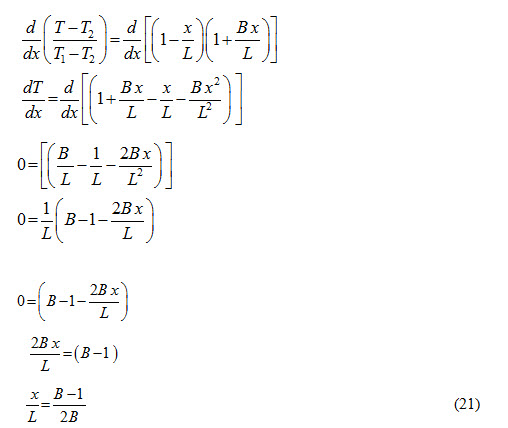
Equation (21) gives the location of maximum temperature in the slab. The equation representing the maximum value of temperature is obtained by substituting the value of maximum x /L from equation (21) into equation (20).
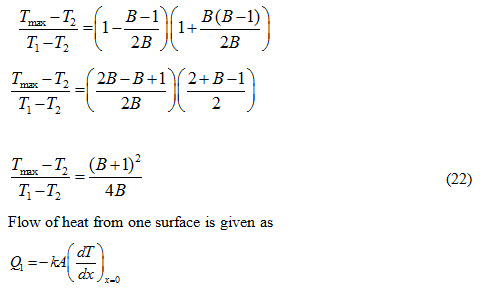
Flow of heat from one surface is given as

From equation (14) substituting the value of dT/dx, we get

Substituting the value of C1 from equation (17), we get
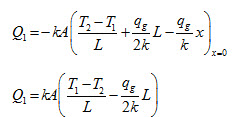
Similarly heat flow from the other surface

In case maximum temperature occurs inside the slab, heat will flow from both surfaces of the slab and total heat flow will be given as:
QT = Q1+Q2
In case T1 is the maximum temperature, heat will flow towards x (+ve only) and heat lost will be given as:
QT = Q2
One-Dimensional Heat Flow through a cylinder with Heat Generation
i) A hollow Cylinder:
Consider a hollow cylinder of length L having inner and outer radii r1 and r2 respectively in which flow of heat is unidirectional along the radial direction. T1 and T2 are temperatures of the inner and outer surfaces of the cylinder respectively. In order to determine temperature distribution and heat flow rate, a small element at radius r and thickness dr is considered. A heat source present inside the strip is generating qg amount of heat per unit volume as shown in Figure 3.
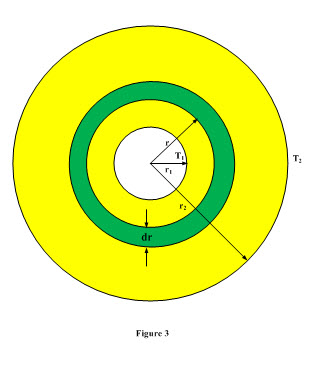
Heat conducted into the element, Qr = -k(2 Π r L) dT/dr (23)
Heat generated in the element, Qg = 2 Π r L dr qg (24)
Heat conducted out of the element, ![]()
For steady state condition of heat flow
Heat conducted into the element + Heat generated in the element = Heat conducted out of the element

Substituting the values of Qr and Qg from equations (23 and 24) in equation (26), we get

In order to find out the solution of the above equation, integrate it with respect to r

Integrating equation (4.28) again with respect to r, we get

C1 and C2 are constants of integration and the expressions for these constants can be found out by using the following boundary conditions
At r=r1, T=T1 and at r=r2, T=T2

Subtracting equation (32) from equation (31), we get
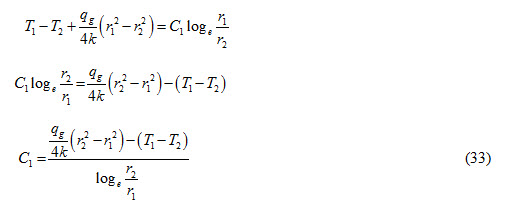
Substituting the value of C1 in equation (31), we get
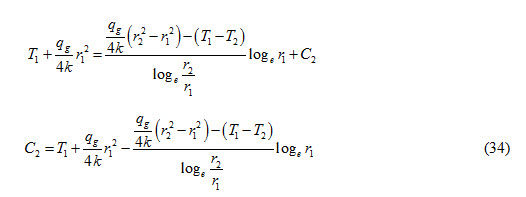
Substituting the values of C1 and C2 in equation (30), we get
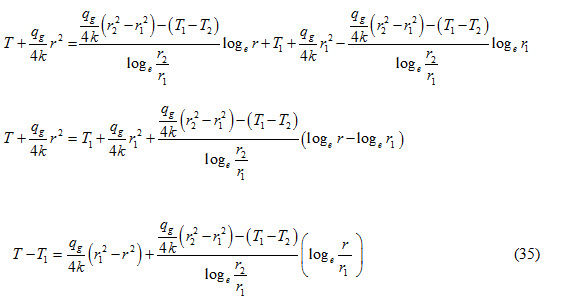
Dividing both sides of equation (35) by T1-T2, we get
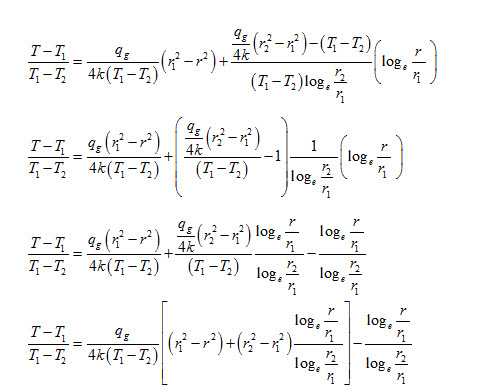
Multiplying and diving Right Hand Side of the above equation by r2, we get

Equation (36) represents temperature distribution inside a hollow cylinder with heat generation.
ii) A Solid Cylinder
In case of solid cylinder, the governing equation remains same as equation (30)

Differentiating above equation with respect to r, we get

Applying the boundary conditions

Substituting the values of C1 and C2 in equation (30), we get
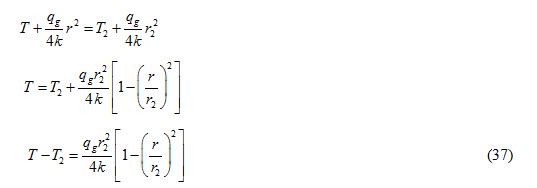
Equation (37) represents temperature distribution equation in a solid cylinder with heat generation. Maximum temperature will occur at r=r2, and will be expressed as

Dividing equation (37) by equation (38), we get

Heat flow through a solid cylinder is expressed as
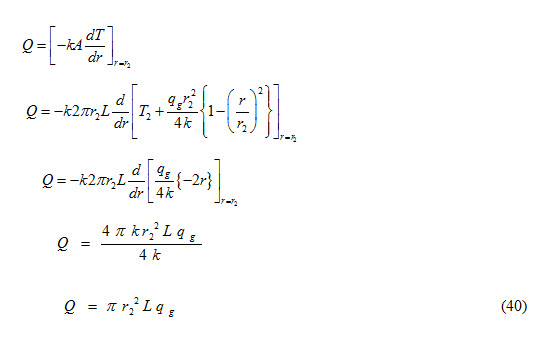
Heat conducted = Volume of cylinder x heat generating capacity per unit volume per unit Time
For steady state conditions, heat conducted at r = r2 must be equal to heat convected from outer surface of cylinder to the surrounding fluid.
Heat Conducted = Heat convected
From equation (40), we can write
![]()
Tf is temperature of fluid surrounding the cylinder.

Substituting the value of T2 in equation (37), we get

One-Dimensional Heat Flow through a sphere with Heat Generation
Consider steady state heat conduction through a hollow sphere having r1 and r2 as inner and outer radii respectively. Temperature of the inner and outer surfaces is T1 and T2 respectively. Heat is flowing from inner to outer surface as T1 is greater than T2 as shown in Figure 4.
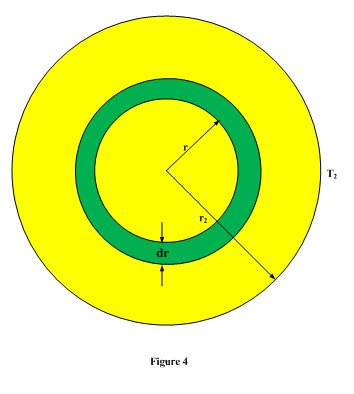
The general conduction equation which governs the conduction heat transfer is written as

Since it is a case of one-dimensional, stead heat conduction through a wall of uniform conductivity with heat generation, therefore, 
Therefore, equation (41) reduces to

The above equation can be written as

Integrating equation (43) with respect to r, we get
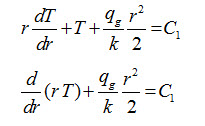
Upon integrating above equation once more with respect to r, we get

Applying the first boundary condition i.e. at r = 0, dT/dr = 0 to equation (44), we get
C2 = 0 (45)
Applying the second boundary condition i.e at r = r2, T =T2 to equation (43), we get

Substituting the values of C1 and C2 in equation (44), we get
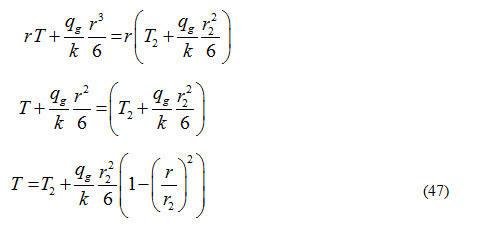
Equation (47) represents temperature distribution equation in a solid sphere having a heat source present inside it.
Heat flow rate through a sphere with heat generation can be determined by using the following equation

Heat conducted = Volume of sphere x heat generating capacity
For steady state conditions, heat conducted through a sphere must be equal to heat convected from outer surface of the sphere
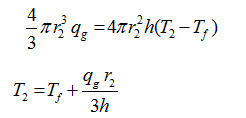
Substitute the value of T2 from above equation in equation (47), we get
